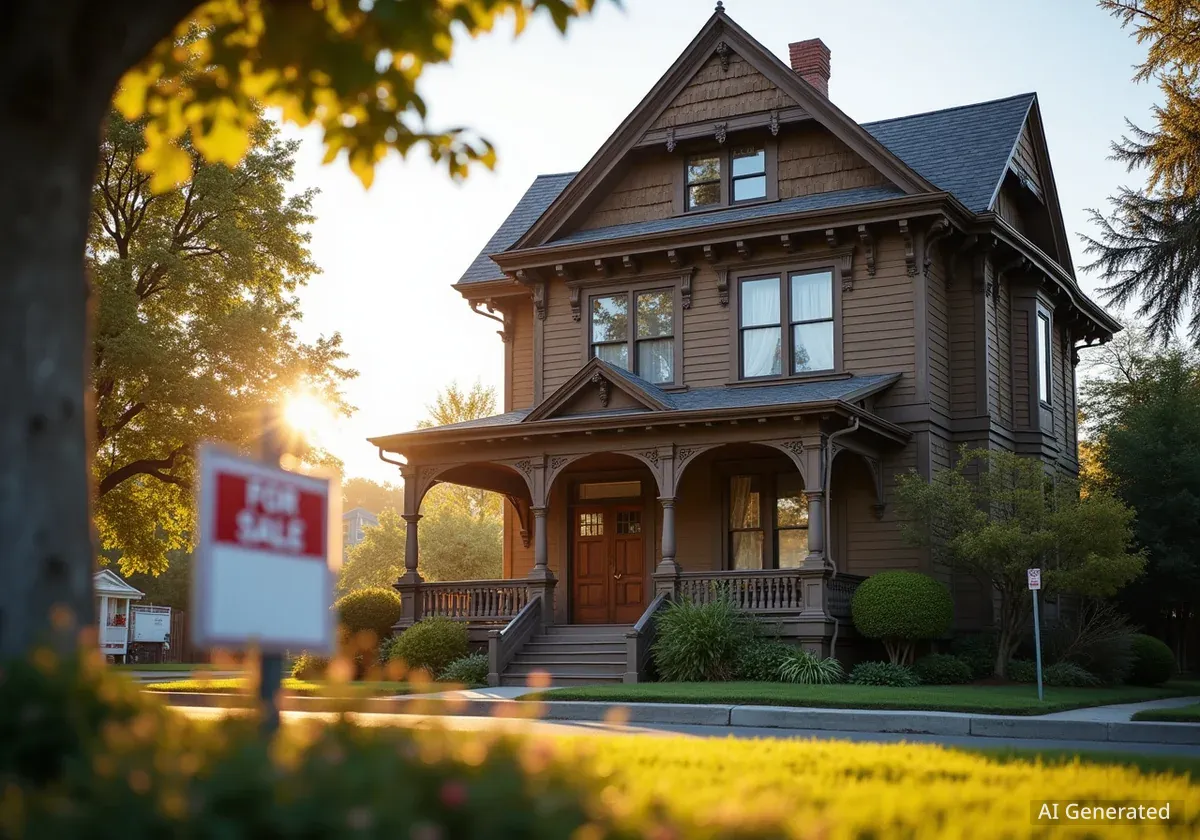Alameda's oldest home, a Gothic Revival cottage built on the East Coast in 1854, has been listed for sale at $1.4 million. The historic property, known as the Webster House, embarked on a five-month sea voyage around Cape Horn before being reassembled in what was then a burgeoning Bay Area community.
Key Takeaways
- The oldest home in Alameda, built in 1854, is on the market for $1.4 million.
- Originally constructed in New York, the house was disassembled and shipped around South America to California.
- The property has survived two fires and served as a bed and breakfast before being converted back to a single-family residence.
- The home features six bedrooms, 4.5 bathrooms, and a detached studio on a 6,608-square-foot lot.
A Transcontinental Journey
Long before Alameda was incorporated as a city in 1872, the Webster House began its existence thousands of miles away. The home was designed in the early 1850s by Andrew Jackson Downing, a prominent New York architect, for its original owners, John Nelson and Caroline Webster.
In an era of westward expansion, this was no ordinary construction. The house was a prefabricated structure, built in New York, then carefully taken apart for its journey to the Pacific Coast. It was loaded onto a ship for a perilous voyage that predated the Panama Canal by more than 60 years.
The Cape Horn Route
The journey around Cape Horn was the primary maritime route between the Atlantic and Pacific oceans in the mid-19th century. According to historical records from the Library of Congress, such a trip could easily take five months, exposing ships and cargo to some of the world's most treacherous waters.
The home was eventually reassembled at 1238 Versailles Ave., where it stands today as a testament to the ambition of early California settlers. At the time, the area was not a unified city but a collection of three small communities: Old Alameda, the Encinal, and Woodstock.
A History of Resilience and Reinvention
The home's remarkable story did not end with its arrival in the Bay Area. Over its 170-year history, the Webster House has demonstrated extraordinary resilience. It survived two significant fires, one in the late 1800s and another in the early 1920s.
In more recent decades, the property found a new purpose. During the 1990s and 2000s, it was operated as a popular bed and breakfast, welcoming guests to experience a piece of local history. This chapter of its life is commemorated on a bronze plaque that now sits in front of the home.
The most recent owners have since returned the property to its original function as a single-family residence, carefully stewarding its historic character while adapting it for modern life.
Modern Comforts in a Historic Setting
Today, the Webster House offers a unique blend of past and present. The property has been configured into a spacious six-bedroom, 4.5-bathroom home. A detached studio provides additional flexible space for an office, gym, or guest quarters.
Situated on a generous 6,608-square-foot lot, the home is surrounded by mature trees that offer privacy and shade. The seller, Roger Billerey, noted the unique environment this creates.
"The large front yard and mature trees offer quiet, privacy, and cooler temperatures in the summer, and houses a variety of adorable squirrels and birds," Billerey stated.
The location combines this natural tranquility with urban convenience. It is located near the shops and restaurants on Park Street, one of Alameda's main commercial corridors.
Preserving a Piece of Alameda's Soul
The sale of the Webster House represents a rare opportunity to own a foundational piece of Alameda's history. Real estate professionals involved with the listing emphasize its cultural significance.
Architectural Significance
The home is a prime example of the Gothic Revival style, popularized by its designer, Andrew Jackson Downing. This style is characterized by features like steep gables, pointed arches, and decorative trim, all of which are visible in the Webster House's design.
Compass agent Kate McCaffrey, who is handling the listing, spoke about the home's connection to the city's origins.
"Homes like this one connect us directly to the Island’s earliest days, when there were barely a hundred houses here," McCaffrey explained. She expressed a hope that the next steward of the property will continue to cherish its unique heritage.
"My hope is that the next owner will love and preserve its Gothic Revival character and the incredible story it tells about Alameda’s beginnings."
As the Webster House enters the next chapter of its long and storied life, it stands as more than just a residence. It is a living link to the very foundations of the city it has watched grow for nearly two centuries.





